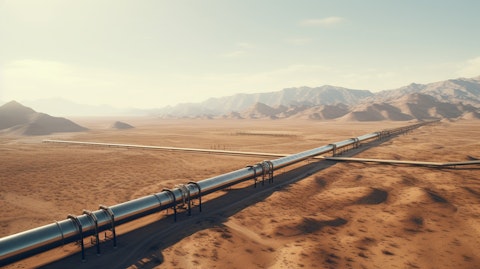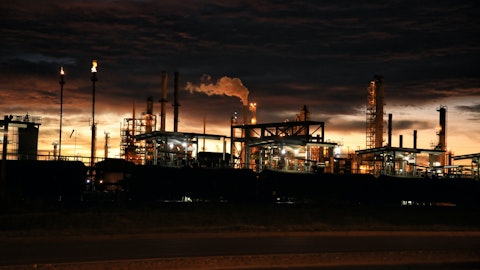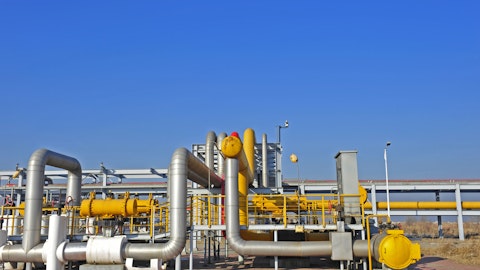Plains All American Pipeline, L.P. (NASDAQ:PAA) Q4 2023 Earnings Call Transcript February 9, 2024
Plains All American Pipeline, L.P. beats earnings expectations. Reported EPS is $0.4451, expectations were $0.37. Plains All American Pipeline, L.P. isn’t one of the 30 most popular stocks among hedge funds at the end of the third quarter (see the details here).
Operator: Good day and thank you for standing by. Welcome to PAA and PAGP Fourth Quarter 2023 Earnings Conference Call. At this time, all participants are in a listen-only mode. After the speaker’s presentation, there will be a question-and-answer session. [Operator Instructions] Please be advised that today’s conference is being recorded. I would now like to hand the conference over to your speaker today, Blake Fernandez, Vice President of Investor Relations. Please go ahead, sir.
Blake Fernandez: Thank you, Dan. Good morning and welcome to Plains All American fourth quarter 2023 earnings call. Today’s slide presentation is posted on the Investor Relations website under the News and Events section at plains.com. An audio replay will also be available following today’s call. Important disclosures regarding forward-looking statements and non-GAAP financial measures are provided on Slide 2. An overview of today’s call is provided on Slide 3. A condensed consolidating balance sheet for PAGP and other reference materials are in the appendix. Today’s call will be hosted by Willie Chiang, our Chairman and CEO; and Al Swanson, Executive Vice President and CFO as well as other members of our management team. With that, I will turn the call over to Willie.
Willie Chiang: Thanks, Blake. Good morning, everyone, and thank you for joining us. Today, we reported fourth quarter and full year results exceeding expectations in both our Crude Oil and NGL segments. We’ve made considerable progress towards our long-term strategy while demonstrating continuous execution of our goals and initiatives. In summary, fourth quarter and full year adjusted EBITDA attributable to PAA was $737 million and $2.71 billion respectively, with full year results exceeding the midpoint of our initial guidance by approximately $210 million or 8%. We lowered our long-term leverage ratio target range to 3.25x to 3.75x and we ended 2023 with a leverage ratio of 3.1x. Our efforts to enhance the balance sheet were recognized by the credit rating agencies with two recent upgrades to mid BBB.
Additionally, we completed several win-win strategic transactions in both in our Crude Oil and NGL segments and including three Permian gathering bolt-on transactions, the sale of our interest in a Canadian fractionation facility, and the recent divestiture of approximately 600 crude oil railcars for proceeds of approximately $40 million. These transactions are representative of our ongoing efforts to optimize our asset base and streamline our operations while generating attractive returns for unitholders. The strong EBITDA results along with the recent bolt-on transactions and lower leverage helped to underpin a $0.20 per unit annualized increase in our common unit distribution level, which will be payable later this month and represents a 19% increase in the annualized distribution relative to 2023 levels.
Turning to Slide 4, it should come as no surprise that our 2024 key focus areas remain very consistent with last year’s. Our strong operational and equity performance over the past year only serves to reaffirm our strategy, most notably our focus on generating meaningful free cash flow, our commitment to capital discipline and a clear and concise capital allocation framework focused on increasing return of capital to equity holders, while maintaining a strong balance sheet and financial flexibility. As highlighted on Slide 5, we expect adjusted EBITDA attributable to PAA of $2.625 billion to $2.725 billion for 2024. This reflects year-over-year growth in our Crude Oil segment underpinned by continued Permian production and tariff volume growth as well as contributions from recent bolt-on acquisitions.
Our guidance also factors in a reduction in our NGL segment, primarily driven by lower forecasted frac spreads year-over-year. As shown on Slide 6, we anticipate 2024 Permian crude oil production growth to be between 200,000 to 300,000 barrels a day exit with the Delaware Basin driving the majority of the growth. Our updated forecast assumes an average of 300 to 320 horizontal rigs, and as part of our routine fundamentals forecasting process, we will continue monitoring our assumptions as the year progresses. Our Permian JV system is well-positioned with more than 4.4 million long-term dedicated acres and operating leverage to provide customers with Midstream solutions from the wellhead to demand centers. As we show on Slide 7, we expect to capture approximately 275,000 barrels a day of incremental gathering tariff volumes for the full year 2024.
For our long-haul systems, we continue to expect high utilization on our Corpus bound assets, a volume step up on basin pipeline and an MVC step up on Wink-to-Webster. In our NGL segment, we continue to focus on optimizing the business and improving the durability of our earnings. During 2023, we closed the sale of our JV interest in Keyera Fort Sask and we sanctioned a 30,000 barrel day debottleneck of the Plains Fort Sask complex. The debottleneck project remains on budget and unchanged in service date of mid-2025. With that, I’ll turn the call over to Al.

Al Swanson: Thanks, Willie. We reported fourth quarter adjusted EBITDA of $737 million, which includes Crude Oil segment benefit from Canadian market-based opportunities and increased volumes across our systems, primarily in the Permian along with NGL segment benefits from stronger seasonal sales and higher realized frac spreads. For the full year, we have reported adjusted EBITDA of $2.71 billion. Strong full year performance is primarily driven by higher realized frac spreads, market-based opportunities, strong base business performance and contributions from bolt-on acquisitions. Slides 13 and 14 in today’s appendix contains walk, which provide details on our fourth quarter performance. A summary of our 2024 guidance and key guidance assumptions are on Slide 8.
Looking at 2024 compared to 2023 and as illustrated by the EBITDA walk on Slide 9, we expect adjusted EBITDA of $2.625 billion to $2.725 billion with year-over-year growth in our Crude Oil segment, partially offsetting commodity price headwinds in our NGL segment. Growth in our Crude Oil segment is primarily driven by anticipated tariff volume increases, higher fees from tariff escalators and full year contributions from bolt-on acquisitions. This is partially offset by our assumption of fewer market-based opportunities. We expect lower year-over-year NGL segment adjusted EBITDA, driven by lower forecasted frac spreads, partially offset by higher C3 plus spec product sales in 2024. I would note that our C3 plus spec product sales volumes are approximately 90% hedged for the year in the mid $0.60 per gallon level.
We remain disciplined with our capital investments with approximately $375 million of growth capital and approximately $230 million of maintenance capital expected for the year, net to PAA. This includes capital for POP JV well connections and intra-basin improvement as well as an increase in our capital related to our previously announced Fort Sask debottleneck project. As illustrated on Slide 10 and in addition to a capital discipline, we remain committed to significant returns of capital and maintaining financial ability. For 2024, we expect to generate $1.65 billion of adjusted free cash flow excluding changes in assets and liabilities with approximately $1.15 billion to be allocated to common and preferred distributions inclusive of the respective increases resulting in $500 million of adjusted free cash flow after distributions available for value-creating opportunities, including potential bolt-on acquisitions or net debt reduction.
Regarding our senior note maturity profile, we have $750 million of notes maturing in November 2024, which we would expect to refinance all or a portion of during the year. With that, I’ll turn the call back to Willie.
Willie Chiang: Thanks, Al. Ongoing geopolitical turmoil continues to drive market volatility along with potential impacts to energy and economic policy. Despite this environment, Plains is well positioned today and going forward to continue delivering value to our unitholders. As we show on Slide 11, we’ve made meaningful progress on our long-term goals and initiatives continue to position ourselves to be the partner, employer and the investment of choice. In summary, our balance sheet is much stronger with year-end 2023 leverage at 3.1x. We continue to demonstrate capital discipline and patience as we look at additional opportunities to grow the business organically and inorganically through accretive and synergistic bolt-on acquisitions.
Last but not least, we remain focused on increasing return of capital to our unitholders. We believe the world needs North American energy supply long-term and that our business will perform well in both the near-term and longer-term environment. I’ll turn the call back over to Blake, who can lead us into Q&A.
Blake Fernandez: Thanks Willie. As we enter the Q&A session, please limit yourself to one question and one follow-up. For those with additional questions, please feel free to return to the queue. This will allow all participants an opportunity to ask questions in our available time this morning. The IR team will also be available to address any additional questions you may have. With that, Daniel, I’ll turn the call over to you.
See also 30 Countries With The Happiest Workers in the World and 20 States That Have America’s Strongest Unions.
Q&A Session
Follow Plains All American Pipeline Lp (NYSE:PAA)
Follow Plains All American Pipeline Lp (NYSE:PAA)
Operator: [Operator Instructions] Our first question comes from Michael Blum with Wells Fargo. Your line is now open.
Michael Blum: I wanted to ask a little bit on the ‘24 guidance. Your Permian Basin level growth forecast. It’s pretty close to your own gathering volume growth estimate, and I’m just wondering if you could speak to that. Is that a function of your market share in the basin? Is that just a coincidence? And then, the guidance also assumes a pretty nice jump in Western volumes year-over-year. So I wonder if you can talk about what’s driving that as well.
Willie Chiang: Yes. Michael, this is Willie. The 2.75 maybe for clarity, it is composed of two factors. One, the M&A, the bolt-on transaction volumes that we added last year and that’s about 150,000 barrels a day, and then growth from the growing basin, which is about 125,000 barrels a day. And on the Western volumes, Jeremy, you want comment on that?
Jeremy Goebel: Yes, if you’re speaking about Delaware Basin volumes being Western California. That was due to some downtime at the beginning of last year. So, it’s basically just normalizing to the second half of the year runway and some shut down from California refineries, which pushed more volumes to the pipe. So, it’s a combination of those two things.
Michael Blum: Okay, perfect. Appreciate all that. And then, just wanted to ask, it seems like the open season on Gray Oak is, moving forward, so just wanted to get your views on how you see that impacting your re-contracting efforts on Cactus and then just generally on overall supply versus takeaway out of the basin?
Jeremy Goebel: Sure. So what I would say first is the ray of open season. We expect it to be successful. We’re continuing to have constructive dialogue with our customers and see no reason why that’s going to impact our re-contracting negotiations. As far as takeaway from the basin, the pipes in Corpus are still full, length lifts are still full. We have some flex on a few pipelines in the area, but as basin grows, it will tighten. But it is a constructive market. People know where they want to bring their barrels for — in the future, and we would continue to be positive on the long-haul pipe as time goes.
Operator: Our next question comes from Brian Reynolds with UBS. Your line is now open.
Brian Reynolds: Maybe to follow up on Michael’s question on just the 300,000 barrels of Delaware growth, which you bifurcated between some organic and or inorganic year-over-year, just given high-level Plains is 50% of the market share in the Permian of which I think you’re more highly leveraged at Delaware. Just kind of curious, if you can help us kind of square out kind of that gathering and long-haul guide a little bit more, do you see outside gathering share opportunities in the Delaware just given that more growth is expected to come from there in ‘24?
Jeremy Goebel: So, I think Willie outlined the sources of the gathering growth specifically Midland versus Delaware. It’s a function of activity. So if you look at the number of rigs working in the Delaware, it’s probably 170 to 180. You have closer to 120 working in Midland. When you offset declines in new production, that’s what yields the growth. You had significant growth in the fourth quarter of last year, so you would imagine it to be slower in the first half, stronger in the second half, which is what is consistent with some of the public EMPs that have guided so far this year. So, the Delaware Basin growth is a function of activity. We do have a stronger position in the Delaware Basin, so that impacts us disproportionately.
So, I’d say that’s that piece. That’s for the long-haul guide. I think you were referring to the fourth quarter versus the full year long-haul numbers. And what I would say there is, we had outside contribution of basin in the fourth quarter, a more normalized view for the year next year.
Brian Reynolds: Maybe that’s my follow-up switch to capital location. Plains enters ‘24 with a similar Tier 1 free cash flow yield in the space similar to ‘23. Last year, we saw debt reduction in some opportunistic M&A along with the distribution bump. So, kind of curious, as we look ahead to ‘24 preferences of that excess cash and specifically on M&A, do you see a similar amount of like bolt-on opportunities in ‘24? Are they more limited at this juncture to where debt reduction might be the preference next?
Al Swanson: This is Al. Our focus will be to continue to look at potential to make investments that are accretive to our valuation. We’re hopeful that we’ll be successful on some bolt-on acquisitions, but we don’t know. We feel in the near term, if we aren’t successful with that again continuing to re reduce debt is not a bad alternative pending that opportunity set. We do not specifically believe that we need to continue to reduce debt. However, our priority will continue to focus on investing, returning more cash through distributions, and looking for other value opportunities around using that cash flow.
Willie Chiang: Maybe I’ll add something to what Al said. When you think about the evolution of where we are, I’m not saying anything people don’t know, but it’s pretty remarkable where the industry has gone as far as shifting to an export market. A lot of capital has gone into the industry in the last decade. And I think what we’re seeing right now is really kind of a change in the business cycle focus on returns, which really is going to reinforce more opportunities for asset sales consolidation. And really to address your question, I do think there are going to be more opportunities in there and frankly, we just need to be very patient and capture it. Our asset base, as is well situated to be able to capture synergies across the system in many of the basins we operate, but particularly the Permian. And the key now is to stay very disciplined, and at the right valuations, I think we can add bolt-on just as we did last year.
Operator: And our next question comes from Keith Stanley with Wolfe. Your line is now open.
Keith Stanley: Could you maybe on Cactus, just give a little more color on where you are at working to re-contract that pipeline timing of when you hope to resolve it and high level goals for that? And I guess just big picture how you’re thinking about a desire to have contracts with medium term duration versus operating the pipeline on a less contracted basis, depending on where price settles out?
Jeremy Goebel: Keith, this is Jeremy. What I would say is, it’s constructive for us to have those dialogues now versus where it was the last couple years. We expect to give you guys an update on that this year, but for competitive reasons it doesn’t make sense to right now. What I would say is, there’s usually a mix and it’s largely we have to clear the base and these pipes need to move barrels every day. The owners of the capacity on that pipeline should be someone with ratable export takeaway, because that’s where it’s going. In a lot of respect it makes sense to contract those pipelines with the third-parties that will be exporting the barrels. We serve the function of aggregating barrels from the lease to the market center.
We have the liquidity in our terminals. They like to partner with us. It’s matching up the supply on one end with their takeaway on the other. It needs to have a strike a good balance of contracting with third-parties and some marketing opportunities. But for us, it’s more weighted to contracting and partnering up with the off-takers like the Wink-to-Webster to refiners like our Corpus pipelines as the exporters.
Willie Chiang: Keith just to make a reinforce the point that Jerry made. Many people we talk to think that our partners could disappear. We’ve got great partners on this line, folks that are shipping. And so, the way I would couch this is, we’ve got a great relationship with our partners and the shippers on the line, and this is just a normal course of business that you have to go on renegotiation as far as term and tariff.
Keith Stanley: Got it. Thanks. Second question just, the Company has had really good market-based results the past two years on Canadian crude spreads and NGL market dynamics. I think in Slide 9, you’re assuming fewer market-based opportunities in 2024. Is that a function of their specific areas where you just see less opportunity this year? Or is it just conservatism built-in/kind of a lack of visibility at this point? Just how you would characterize that bucket on market-based opportunities?
Willie Chiang: Yes. Market-based opportunities, you can’t predict them. They are very difficult to figure out when something might happen. Some of this is weather, some of it’s other asset rely on and there’s all kinds of things that factor into this. And we’ve been pretty conscious of not trying to forecast in a large capture for things that we don’t know that’s going to happen. So one of the fundamental changes this year is we have, not we, but the industry has a Trans Mountain, that’s starting up that could impact the opportunities for crude market opportunities. We factor all this in. And to answer your question, we don’t have a tremendous amount of we have a modest amount of market opportunities that we have captured that we think we can probably catch.



